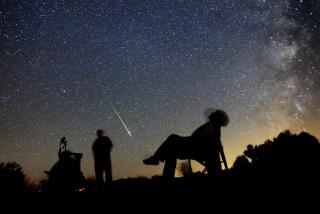A Star Becomes a Comet Watcher : Thomas Cave Built a Reputation With Precision Scopes
- Share via
In that eccentric galaxy of amateur sky watchers, Thomas Cave’s reputation is way, way out there.
He learned astronomy by the seat of his pants--becoming the 11-year-old “club mascot” of an organization of adult Long Beach stargazers before he dazzled grown-ups by promptly building his own mirror telescope out of glass that he ground by hand.
As a teen-ager, he scavenged scrap lumber from Long Beach Harbor and built a back-yard observatory equipped with an 11-foot revolving dome operated by ropes behind his parents’ Roswell Avenue home.
As an adult, he built an optical factory that opened the heavens to the masses by selling precision telescopes at affordable prices. During a 30-year period he constructed nearly 16,000 of them, at the same time crafting another 53,000 mirror lenses sold to do-it-yourselfers who assembled their own scopes.
Finally, when he sold his telescope-making business and retired to national recognition as an expert on the planet Mars, he moved into a home next to his beloved observatory so his handcrafted, 12 3/4-inch mirror telescope would always be close at hand.
So you’d think the 71-year-old Cave would be perfectly positioned, with all the comforts of home, to watch the spectacular comet crashing taking place on Jupiter this week.
Wrong. Turns out the roof and eaves of his new house block the view of the planet from his huge telescope--the one that is so powerful and optically clear that it can reveal stars in the daytime.
That means Cave is in the unusual position of racing around Southern California to watch the once-in-a-lifetime show through other people’s viewfinders. And accompanying him each night is a visiting house guest: Richard McKim, president of the British Astronomical Assn.
It’s been Mt. Wilson one night, Griffith Park the next and then the Lakewood back yard of an amateur astronomer after that. Next stop for the pair is the Lowell Observatory in Flagstaff, Ariz.
“It’s magnificent. This is a once-in-a-millenium thing. It’s never happened in the history of astronomy,” Cave said Tuesday as he sat inside his observatory on the oak telescope viewing platform he has used for 54 years. “It’s very exciting.”
The bombardment of Jupiter by two-mile-wide hunks of the Comet Shoemaker-Levy 9 have left astronomers around the world gasping in amazement.
So far, he and Cave have only seen the comet’s impact sites--not the flying comet, said McKim, of Oundle, Northamptonshire, England. But that in itself has been plenty spectacular.
Cave is pleased that the telescope his Lakewood friend has aimed at Jupiter is one he built during the heyday of the Cave Optical Co.
Before the company’s start in 1950, Cave learned the ins and outs of glass grinding at lens makers’ shops in Los Angeles and Long Beach. By then, he had built a second telescope of his own--a giant, 12 1/2-inch mirror instrument. The shop started with simple pottery-wheel grinding machines.
Cave’s telescopes were soon gaining national and international fame. His workers included local amateur astronomers as well as high school students trained as novice glass grinders.
One of them, Richard Norton, went on to become a planetarium director and a college astronomy teacher. Recounting his days as a mirror maker in a recent article in Sky & Telescope magazine, Norton recalled that one of his co-workers was a youthful Richard Bach, who later wrote “Jonathan Livingston Seagull.”
“Cave mirrors were the best and the telescope buyers knew it,” Norton said. “The optical training I had received (there) served me well throughout my career.”
Roger Sinnott, an associate editor of Sky & Telescope, said no one has improved upon the optics that were used by Cave until his company was sold in 1979 and the Cave brand disappeared.
“He probably made the leading telescope sold to amateurs in the ‘50s,” Sinnott said Tuesday from Cambridge, Mass. “His work was cutting-edge quality.”
Cave said he sold his company after being hospitalized. He said his doctors warned him he might die if he did not eliminate the business stress. Cave worked for a while after that in the optical department of Hughes Aircraft to help pay his medical bills.
According to Cave, he realized that his view of the Western skies would be reduced when his two-story retirement house was put in the back of his family’s Roswell Avenue property. But his daughter and her family needed the front house.
“There was nowhere else to build it,” he said, adding that atmospheric conditions to the west over Long Beach were never that good anyway.
“Most of my work is overhead and to the south,” Cave said. The observatory, with its homemade sky-blue dome and its rope pulleys, is every bit as good as fancy Mt. Wilson’s for planetary study, he said. Except for nights when the marine fog layer moves in--or when targets like Jupiter are hidden behind the house--conditions are perfect for “seeing,” as astronomers call it.
Cave has no plans to computerize his 12 3/4-inch reflector telescope with modern devices that automatically hunt for a specific star or planet and aim the telescope at it at the press of a button.
“These new gadgets are taking all the fun out of astronomy,” he said, “You don’t need them if you’ve learned astronomy from the ground up.”
More to Read
Sign up for Essential California
The most important California stories and recommendations in your inbox every morning.
You may occasionally receive promotional content from the Los Angeles Times.













